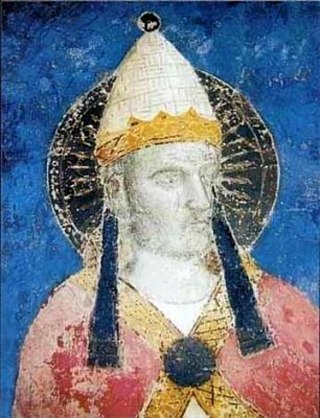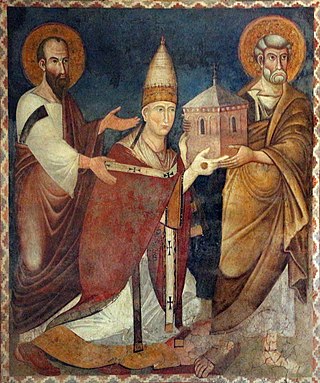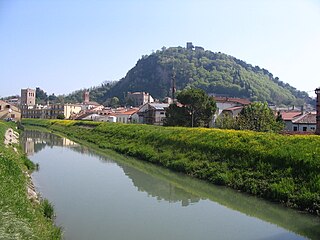Related Research Articles

Pope Alexander IV was head of the Catholic Church and ruler of the Papal States from 12 December 1254 to his death in 1261.

Pope Honorius III, born Cencio Savelli, was head of the Catholic Church and ruler of the Papal States from 18 July 1216 to his death. A canon at the Basilica di Santa Maria Maggiore, he came to hold a number of important administrative positions, including that of Camerlengo. In 1197, he became tutor to the young Frederick II. As pope, he worked to promote the Fifth Crusade, which had been planned under his predecessor, Innocent III. Honorius repeatedly exhorted King Andrew II of Hungary and Emperor Frederick II to fulfill their vows to participate. He also gave approval to the recently formed Dominican and Franciscan religious orders.

Pope Gregory X, born Teobaldo Visconti, was head of the Catholic Church and ruler of the Papal States from 1 September 1271 to his death and was a member of the Secular Franciscan Order. He was elected at the conclusion of a papal election that ran from 1268 to 1271, the longest papal election in the history of the Catholic Church.

Pope Innocent IV, born Sinibaldo Fieschi, was head of the Catholic Church and ruler of the Papal States from 25 June 1243 to his death in 1254.

Pope Innocent V, born Pierre de Tarentaise, was head of the Catholic Church and ruler of the Papal States from 21 January to 22 June 1276. A member of the Order of Preachers, he acquired a reputation as an effective preacher. He held one of the two "Dominican Chairs" at the university of Paris, and was instrumental in helping with drawing up the "program of studies" for the Order. In 1269, Peter of Tarentaise was Provincial of the French Province of Dominicans. He was a close collaborator of Pope Gregory X, who named him Bishop of Ostia and raised him to cardinal in 1273.

Pope Nicholas III, born Giovanni Gaetano Orsini, was head of the Catholic Church and ruler of the Papal States from 25 November 1277 to his death on 22 August 1280.
John of Vercelli was the sixth Master General of the Dominican Order (1264-1283).

Peter of Capua was an Italian scholastic theologian and prelate. He served as cardinal-deacon of Santa Maria in Via Lata from 1193 until 1201 and cardinal-priest of San Marcello al Corso from 1201 until his death. He often worked as a papal legate. He wrote several theological works and was a patron of his hometown of Amalfi.
John of Crema was an Italian papal legate and cardinal. He was a close supporter of Pope Callistus II.
Gerardo Bianchi was an Italian churchman and papal diplomat, an important figure of the War of the Sicilian Vespers.

Jean Lemoine, Jean Le Moine, Johannes Monachus was a French canon lawyer, Cardinal, bishop of Arras and papal legate. He served Boniface VIII as representative to Philip IV of France, and founded the Collège du Cardinal Lemoine, in Paris. He is the first canon lawyer to formulate the legal principle of the presumption of innocence.

The 1159 papal election following the death of Pope Adrian IV resulted in a double papal election. A majority of the cardinals elected Cardinal Rolando of Siena as Pope Alexander III, but a minority refused to recognize him and elected their own candidate Ottaviano de Monticelli, who took the name Victor IV, creating a schism that lasted until 1178.
The 1254 papal election took place following the death of Pope Innocent IV and ended with the choice of Raynaldus de' Conti, who took the name Pope Alexander IV. The election was held in Naples, in the former palazzo of Pietro della Vigna, and required only one day.
Giordano Pironti dei Conti di Terracina was an Italian aristocrat, papal bureaucrat, and Roman Catholic Cardinal. His family included a brother, Pietro, and three nephews, Pietro, Giovanni and Paolo.

Simone Paltanieri, son of Pesce Paltanieri, member of a distinguished family, was an Italian Roman Catholic cardinal.
Bérard de Got was a French bishop and Roman Catholic Cardinal. He was the son of Bérard, Lord of Villandraut, and a brother of Bertrand de Got, who became Pope Clement V.

Graziano da Pisa was a cardinal of the Roman Catholic Church. He was a native of Pisa, and the nephew of Pope Eugenius III (1145-1153). He had studied law in Bologna, and held the rank of Magister. He was a prominent official in the papal chancery, and an accomplished papal diplomat.

Ardicio de Rivoltela was a cardinal of the Roman Catholic Church. He was a native of Piadena (Platina), in the diocese of Cremona in Lombardy. The appellation "de Rivoltela" is mentioned only once, and its significance is unclear.
Melior, O.S.B. Vall. was a Benedictine monk, and a cardinal of the Roman Catholic Church. He was a native of Pisa. He served as papal legate in France for more than three years, trying to arrange a peace between Richard I and Philip II. He became a major negotiator, on the mandate of Pope Celestine III, in the divorce case between King Philip II of France and Queen Ingeborg of Denmark.
Theodinus, O.S.B. was a Benedictine monk, and a cardinal of the Roman Catholic Church. He was a native of Arrone, a hilltop town 15 km east of Terni. He became a cardinal priest, and then cardinal bishop of Porto. He served as a papal diplomat, in Normandy, in the Balkans, and in Venice. He participated in the papal elections of 1181 and 1185.
References
- ↑ Chacón I, p. 1115.
- ↑ Chacón, pp. 1114, 1115.
- ↑ Roger of Hoveden, in: W. Stubbs (ed.), Chronica Magistri Rogeri de Houedene Vol. II (London: Longmans 1869), p. 317: "Eodem anno post Natale Domini Urbanus papa misit in Angliam Octovianum sanctae Romanae ecclesiae subdiaconum cardinalem, et cum eo Hugonem de Nunant, quibus commisit legatiam in Hybernia ad coronandum ibi Johannem filius regis."
- ↑ Kate Norgate (1902), John Lackland (London: Macmillan), pp. 19-20.
- ↑ Onuphrio Panvinio, Romani Pontifices et Cardinales S.R.E. (Venice: Michele Tramezzino 1557), p. 130.
- ↑ Jaffé, p. 578.
- ↑ Volkert Pfaff (1979), "Giordano da Ceccano", Dizionario Biografico degli Italiani 23 (1979). Retrieved: 30 December 2021.
- ↑ Caesar Baronius, Annales Ecclesiastici(in Latin) (ed. Augustinus Theiner) Vol. 19 (Bar-le-Duc: L. Guerin 1869)), pp. 628-630, § 8.
- ↑ Caesar Baronius, Annales Ecclesiastici(in Latin) (ed. Augustinus Theiner) Vol. 20 (Bar-le-Duc: L. Guerin 1870)), p. 26.
- ↑ Gregorovius V. 1 (London 1906), pp. 26-28. A. Tomassetti (ed.), Bullarum diplomatum et privilegiorum sanctorum romanorum pontificum: A Lucio III (an.MCLXXXI) ad Clementem IV (an.MCCLXVIII), editio Taurinensis, Volume 3 (Turin: Franco, Fory and Dalmazzo 1858), pp. 164-166.
- ↑ A. Potthast, Regesta pontificum Romanorum Vol. 1 (Berlin: De Decker 1874), p. 101, nos. 1096, 1100, 1101. The pope's letter to Ingeborg, announcing Ottaviano's appointment: L. de Bréquigny and F. La Porte du Theil, Diplomata, chartae, epistolae, et alia documenta ad res pranciscas spectantia, pars altera, Tomus primus (Paris: J. Nyon 1791), pp. 10-11.
- ↑ L. de Bréquigny and F. La Porte du Theil, pp. 12-14.
- ↑ L. de Bréquigny and F. La Porte du Theil, pp. 15-20.
- ↑ L. de Bréquigny and F. La Porte du Theil, pp. 20-22. The letters to Ottaviano, Philip and Ingeborg are dated 22 October 1200: Potthast, p. 103, 1150, 1151, 1153.
- ↑ Potthast, p. 103, nos. 1124, 1130.
- ↑ Potthast, p. 112, no. 1232.
- ↑ Potthast, p. 114, no. 1249.
- ↑ Potthast, p. 126, no. 1387.
- ↑ Potthast, p. 119, no. 1300, 1301.
- ↑ Potthast, p. 129, no. 1438.
- ↑ Potthast, p. 145, no. 1676.
- ↑ Conradus Eubel (1913). Hierarchia catholica (in Latin). Vol. Tomus 1 (second ed.). Münster: Libreria Regensbergiana. p. 35.